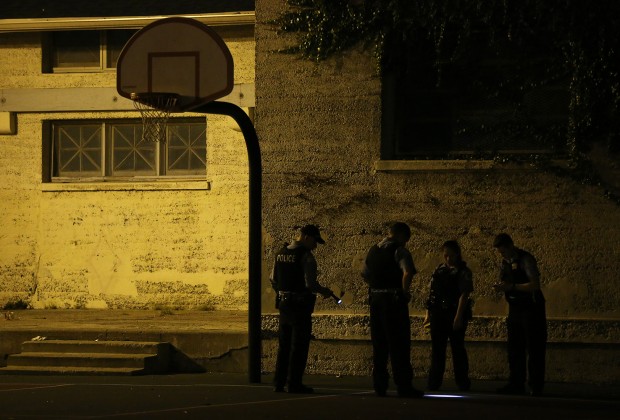Over the past couple years, I've spent a lot of time reading about Chicago crime, and a lot of time reading coverage of Chicago crime. Once that got too oppressive and depressing, I'd pop over to Walgreens or walk down Michigan Avenue, strolling past the tourists and the tourist traps. And in that short walk, I was presented with numerous opportunities to buy Al Capone-branded merchandise of all kinds.
Which has always seemed sort of surreal. I don't recall being able to buy Lucky Luciano keychains in New York. Probably you can, somewhere, but he's not the linchpin of a gangster-nostalgia tourist economy.
Chicago's long had a romance with its violent Prohibition-era past, driving perceptions of it as an unusually violent city, offering regular opportunities for setting the historical record straight. Now Andrew Papachristos, a Chicago-educated (Loyola and the U. of C.) sociologist now at Yale whom I've talked to before, has an editorial in Crain's that's making the rounds: "Chicago the murder capital of the U.S.? Let's get real."
Working off his own research, Papachristos concludes: "First, far from being the most violent city in the U.S., Chicago falls roughly in the middle of the nation in violence and murder rates." It's a point I've made before, though I'm hardly alone in making it.
Around the same time that I read Papachristos's piece, I came across a post from another writer I like, Brendan I. Koerner, author of the excellent hijacking narrative The Skies Belong To Us. As is the case with a lot of people, I suspect, Koerner assumed that Capone-era Chicago was a world-historic bloodbath. Not quite:
For all its notoriety during the 1920s, in fact, Chicago wasn’t even one of the dozen most murderous American cities during the heyday of Capone. In those years, the murder capital of America was a place I would never have expected.
That place clocked in at an astonishing 72.3 murders per 100,000, 15 more than Detroit's 2012 rate. The location might surprise you, but here's a hint: "It’s also worth noting that of the 15 American cities with homicide rates above 20 per 100,000 in 1927, 11 were located in the South. (The non-Southern murder capitals were Kansas City, Detroit, Sacramento, and—believe it or not—Pueblo, Colorado.) "
The FBI's Uniform Crime Reports take us further along. In 1937, Chicago (population almost four million in 1940) had 216 murders. New York City, population 7.5 million, had 331 murders—as has almost always been the case since the mid-1800s, proportionally fewer. Los Angeles, population 1.5 million, had just 81. But Atlanta, less than a tenth Chicago's size, had more than half as many murders: 115. Dallas, about the same size as Atlanta, had 82. Houston, about one-tenth Chicago's size, had 74.
In 1947, Chicago's population is 3.6 million, and there are 209 murders. Houston, now one-sixth Chicago's size, has half as many murders. Richmond, Virginia, population 230,000, had thirty-nine murders. Washington, D.C., at a peak of 850,000, had 65 murders. As Koerner picked up on, Southern cities tended to outpace Northern ones.
Skip ahead a bit. In 1957, University of Pennsylvania sociologist Marvin Wolfgang published the "breakthrough study" Patterns in Criminal Homicide, studying early 1950s trends. His finding?
Wolfgang found that the cities with the highest homicide rates were, in order, Miami (with about 15 homicides per 100,000 people), followed by Dallas; Washington, D.C.; Kansas City, Missouri; Baltimore; Chicago; Cincinnati; and Seattle.
Again, high, but not the highest.
How about when Chicago violence was at its peak?According to FBI data, in 1978, the city recorded 787 murders with a population then down to three million. Again, it outpaced New York City (population seven million, 1,503 murders). But St. Louis, population 450,000, had 210. Detroit, about a third Chicago's size, had, proportionally, about twice as many murders. Houston, now about half Chicago's size, had 484.
In 1994, one of the deadliest on record, Chicago had 937 murders, with, again, a population around three million. Again, Baltimore had proportionally more by a considerable number: 321 in a city less than a third as large. Birmingham, about a tenth as big as Chicago, had 135. Detroit, about a third as big, had 541. Richmond had 160 murders with a population of 200,000. Washington, D.C., 499 murders in a city about a fifth Chicago's size.
This is not to say Chicago is not historically violent. It is, consistently, quite violent, and has been since before the 20th century began. As Greg Hinz has pointed out, it's pretty much always been more murderous than New York and Los Angeles. But its reputation, borne of a gangland past now romanticized on tourist-trap t-shirts, precedes its reality year after year after year.




